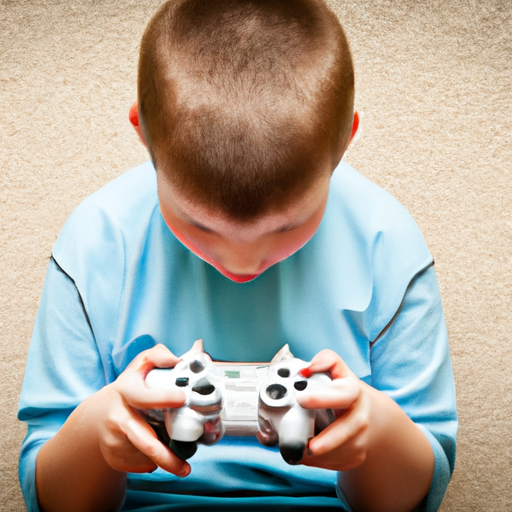How Long Should a 10-Year-Old Play Video Games per Day?
How Long Should a 10-Year-Old Play Video Games Per Day: Introduction
Are you a parent grappling with the question of how long should a 10-year-old play video games per day? If so, you’re not alone. In a world increasingly driven by digital technology, it’s essential to understand the implications of screen time on a young child’s growth and development.
Video games can be entertaining and even educational, offering opportunities for problem-solving, teamwork, and creativity. However, excessive gaming can have detrimental effects, including reduced physical activity, disrupted sleep, and less time for other crucial activities like homework and social interactions.
In this article, we aim to provide a comprehensive look at the recommended video game time for a 10-year-old. We’ll delve into expert advice, consider the content and type of video games, and also discuss how gaming interacts with the overall well-being of your child. Our goal is to arm you with the knowledge needed to make well-informed decisions that ensure a balanced and healthy lifestyle for your young gamer.
Setting Limits on Screen Time
Importance of Setting Limits
Setting limits on screen time is more than just a rule; it’s a proactive approach to your child’s overall well-being. Excessive screen time has been linked to a variety of issues, ranging from sleep disturbances to a higher risk of obesity. Moreover, too much time in front of a screen can result in decreased social skills, as it often comes at the expense of real-world interactions.
Take, for instance, a child engrossed in an online game. The lack of limits might mean they miss out on a family outing, a soccer game, or simply playing outside, all of which offer their own developmental benefits. By setting boundaries, parents can ensure that children are exposed to diverse experiences that contribute to their physical, social, and emotional development.
Recommended Guidelines
The American Academy of Pediatrics (AAP) sets forth guidelines that can serve as a starting point for parents concerned about screen time. For kids aged 6 and older, the recommendation is to limit recreational screen time to no more than two hours per day. These guidelines emphasize quality over quantity, recommending “high-quality programming” even within that limited time.
However, it’s worth noting that these are not one-size-fits-all rules. A teenager using a computer for homework, for example, might legitimately need more screen time than a younger child watching cartoons. So while the AAP guidelines are useful, they should not be the only factor in your decision-making process.
Considering Individual Needs and Circumstances
Every child is unique, and what works for one might not work for another. For example, a child who is particularly active in sports and outdoor activities may have less free time for screens but might also need some downtime. In contrast, a child who struggles with social interaction might use screen time as a crutch, and thus might benefit from more structured limits.
Also, consider different types of screen time. Educational apps or videos can be beneficial and might be treated differently than purely recreational screen time. The key is to create a balanced approach that factors in a child’s individual needs, developmental stage, and even their day-to-day schedule. Tailoring the rules to fit these individual circumstances can make the implementation of screen time limits both more effective and more reasonable.
Understanding the Effects of Excessive Gaming
Health Concerns
Excessive gaming can have detrimental effects on a child’s health. Sitting for long periods without proper breaks can lead to a sedentary lifestyle and contribute to obesity. Additionally, prolonged exposure to screens can strain the eyes, leading to issues like digital eye strain and dryness. It is essential to monitor and reduce the amount of time spent gaming to promote physical health.
Academic Impact
Excessive gaming can also impact a child’s academic performance. Spending excessive time playing video games can take away from time that could be spent on homework, studying, and engaging in other educational activities. This can result in lower grades and a lack of focus in the classroom.
Social and Emotional Development
While gaming can provide opportunities for social interaction and teamwork, excessive gaming can have negative effects on a child’s social and emotional development. Spending excessive time gaming may result in isolation from peers and neglect of other interests and hobbies. It is crucial to find a balance that allows for socialization and exploration of other activities to promote well-rounded development.

Factors to Consider
Age and Developmental Stage
Understanding the age and developmental stage of a child is crucial for setting the right screen time limits. For example, the American Academy of Pediatrics advises that children aged 2 to 5 should have no more than one hour of screen time per day. As children grow, these guidelines can be adapted, taking into account their maturity and ability to manage screen time responsibly.
Teens might have a bit more freedom but should still follow general recommendations. For instance, educational screen time like online classes might be excluded from general limits. Always consider a child’s age and developmental readiness when crafting a screen-time policy.
Other Activities and Responsibilities
It’s not just about the screen; it’s about the rest of a child’s life too. A balanced life involves physical activities, face-to-face social interactions, hobbies, and chores. For example, you could establish a rule that screen time is allowed only after homework is completed and chores are done.
Creating a daily or weekly schedule can help maintain this balance. Allocating specific time slots for activities like family outings, sports, or arts and crafts ensures a healthy mix. This diverse range of activities not only breaks the monotony but also aids in the holistic development of the child.
Family Values and Priorities
Every family is unique, and what works for one may not work for another. Some families prioritize outdoor activities and physical fitness, while others may focus on academic achievement. In any case, open communication within the family is key.
Having a family meeting to discuss screen time can be an effective way to get everyone on the same page. During these discussions, parents and children can share their perspectives. The family can then collaboratively set screen time limits that reflect their values and priorities. This ensures that the rules aren’t just imposed but are the result of a shared understanding of what’s best for everyone.
Benefits of Video Games
Enhancing Cognitive Skills
Video games offer more than just entertainment; they can also be a mental workout. Games that involve puzzles or problem-solving can stimulate the brain. These types of games improve skills like quick thinking and decision-making.
Furthermore, they enhance memory and attention span. Children who play these games show better ability to focus and recall information. Moreover, games that feature complex levels can develop spatial reasoning skills. Understanding three-dimensional space in these games has real-world applications.
Social Interaction and Teamwork
The social aspect of gaming is significant, especially with the rise of multiplayer options. These games, when monitored, offer a safe space for children to interact. This interaction often requires coordination and teamwork.
Games that encourage collaboration promote a range of social skills. Players learn to communicate effectively and make joint decisions. These skills are not just for the virtual world; they apply to real-world interactions and can be particularly valuable in team settings.
Educational Value
Educational video games are becoming more prevalent and offer an engaging way to learn. Whether it’s language, math, or science, there’s likely a game designed to teach it. These games make learning interactive, offering a fun alternative to traditional methods.
Moreover, real-time feedback in these games can highlight areas for improvement. This interactive approach to learning can make even complex subjects more approachable. Thus, educational games not only support academic skills but also encourage a love for learning.

Creating a Balanced Gaming Routine
Establishing Clear Rules and Expectations
Setting boundaries is a key step toward responsible gaming. Begin by having an open conversation with your child about why limitations on gaming are necessary. This could involve discussing the importance of balancing screen time with other activities, like homework and outdoor play. Use this discussion to collaboratively set rules about when and for how long gaming is allowed. Emphasize that these guidelines are not meant to punish but to ensure a well-rounded life.
Teaching Time Management and Responsibility
Good time management isn’t just a skill for adults; it’s a life lesson that children benefit from learning early. Teach them to allocate specific time slots for gaming, homework, and other activities. Tools like timers or apps can help them monitor their time effectively. This approach helps them understand the value of balance, making them more responsible in how they prioritize their time.
Encouraging Physical Activity and Outdoor Play
While gaming can be engaging, it’s crucial to offset the sedentary time with physical exercise. The benefits of physical activity are multifaceted, affecting not just physical health but also mental well-being. Encourage your child to join a local sports team, take family walks, or even just play outside with friends. The aim is to create a lifestyle where gaming is balanced with other enriching activities.
Identifying Signs of Excessive Gaming
Isolation and Neglected Interests
A red flag for problematic gaming is when your child starts withdrawing from family and friends. If they begin to forgo social events to stay home and game or show diminished interest in activities they once enjoyed, it’s time to reassess their gaming habits. Such isolation can affect their social skills and emotional development.
Difficulty Concentrating or Sleep Issues
If your child starts to show decreased attention span or difficulties in schoolwork, take note. Excessive screen time, especially close to bedtime, can also lead to sleep disturbances like insomnia. Sleep is essential for a child’s development, and inadequate sleep can impact everything from academic performance to mood.
Mood Changes and Aggression
Unusually frequent mood swings or an increase in aggressive behavior can be concerning. It may be tempting to dismiss such changes as typical child behavior, but they could be signs of excessive or problematic gaming. A balanced approach to screen time helps in emotional regulation, so consider these behavioral changes as cues to evaluate your child’s gaming habits.

Seeking Professional Guidance
Consulting Pediatricians or Child Psychologists
If you have worries about your child’s gaming habits, don’t hesitate to consult a professional. Pediatricians and child psychologists can give personalized advice tailored to your child’s needs.
They can conduct assessments to understand the psychological and physical impact of gaming on your child. These evaluations can then help you decide if your child’s screen time is within a healthy range or if you need to intervene.
Utilizing Parental Control Features
Gaming devices aren’t just about play; they also come equipped with control settings for parents. Use the built-in parental control features to manage your child’s gaming activities.
These controls can help you set time limits on gaming or block access to certain games based on their age rating. By actively managing these settings, you can instill better gaming habits and ensure a balanced digital lifestyle for your child.
Joining Supportive Communities
You’re not alone in wanting to guide your child toward responsible gaming. Many other parents share your concerns and can offer advice or empathy.
Consider joining an online forum or local support group where you can share experiences and solutions. These communities can offer you strategies to manage screen time and suggest ways to get your child interested in other activities. They can also be a great source for reviews on age-appropriate games and effective parenting tools.
Understanding the Impact of Different Game Genres
Violence and Mature Content
Different game genres come with varying levels of violence and mature content. It’s crucial to understand what your child might be exposed to.
Check the game’s rating system and even consider playing it yourself. This allows you to set age-appropriate boundaries and ensure a safe gaming environment for your child.
Interactive vs. Passive Gameplay
Games can either offer interactive or passive gameplay experiences. Interactive games require active mental and physical engagement.
On the other hand, passive games are more about observing than participating. A balanced mix of both can offer a well-rounded gaming experience. This approach also minimizes the potential negative effects of too much screen time.
Engaging Educational Games
There are games explicitly designed to be educational. These offer more than just entertainment; they also serve as learning tools.
Incorporating these educational games alongside more recreational ones can provide a balanced gaming experience. It also gives your child the opportunity to develop a wide range of skills while having fun.

Teaching Healthy Gaming Habits
Encouraging Variety in Game Selections
One of the best ways to ensure a healthy gaming experience for your child is to encourage them to explore a variety of game genres. For instance, if your child loves action games, perhaps introduce them to puzzles or educational games. This not only exposes them to different types of gameplay mechanics but also helps them broaden their cognitive skills. Diversifying their game selection helps them become more adaptable and could spark interest in new and educational topics.
Setting Specific Time Limits
While it may be tempting to issue a blanket statement like “only one hour of gaming a day,” setting more specific time limits can be far more effective. For example, designate certain hours for gameplay, such as after homework is finished but before dinner. Make sure to discuss these limitations openly with your child, emphasizing the reasons for such boundaries. With clearly defined time limits, children are more likely to stick to a healthy routine, and it makes it easier for them to balance gaming with other important activities, like physical exercise or socializing.
Encouraging Mindful and Balanced Gaming
Mindfulness isn’t just for adults; it’s a useful tool for children as well, especially when it comes to gaming. Encourage your child to be mindful of how long they’ve been playing and how they’re feeling during gameplay. Are they becoming frustrated or agitated? That might be a good time for a break. In addition, encourage physical activity breaks such as a quick walk or some stretching exercises in between gaming sessions. This practice not only helps to physically refresh them but also serves as a mental break, giving them a moment to step back and refocus.
Also, make it a point to emphasize the importance of balancing gaming with other activities, whether it’s going outside to play, working on school projects, or participating in family activities. By teaching them to balance their interests, you’re helping them lay the foundations for a healthy lifestyle that includes but isn’t defined by, gaming.
How Long Should a 10-Year-Old Play Video Games Per Day: Conclusion
Figuring out how long a 10-year-old should play video games per day is a complex issue that goes beyond just setting a timer. While video games can offer educational and recreational benefits, moderation is key to ensuring that they don’t interfere with other important aspects of your child’s life, such as physical activity, academic responsibilities, and social interactions.
Our exploration of expert recommendations and research shows that there is no one-size-fits-all answer to this question. Each family’s approach may differ based on a variety of factors, including the child’s maturity level, the type of games being played, and individual family values.
That being said, it’s important for parents to be actively involved in their child’s gaming life, setting appropriate boundaries and regularly discussing the pros and cons of gaming. A balanced approach is crucial for fostering not just responsible gaming habits, but also a well-rounded, healthy child.
In the end, the key takeaway is to establish a balanced routine that allows your 10-year-old to enjoy video games in a healthy way while also attending to other essential activities and responsibilities. By doing so, you can help create a harmonious environment that supports your child’s overall well-being.




